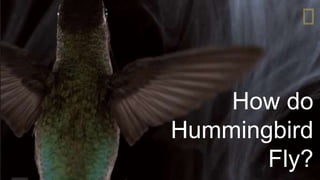
How do Hummingbirds fly2.pptx
- 2. Flapping wings move through two basic half- strokes
- 3. The downstroke starts up and back and is plunged downward and forward. Then the wing is quickly flipped over (supination) so that the leading edge is pointed backward.
- 4. The upstroke then pushes the wing upward and backward. Then the wing is flipped again (pronation) and another downstroke can occur.
- 5. The first attempts to understand flapping wings assumed a quasi-steady state. This means that the air flow over the wing at any given time was assumed to be the same as how the flow would be over a non-flapping, steady-state wing at the same angle of attack.
- 6. By dividing the flapping wing into a large number of motionless positions and then analyzing each position, it would be possible to create a timeline of the instantaneous forces on the wing at every moment. The calculated lift was found to be too small by a factor of three, so researchers realized that there must be unsteady phenomena providing aerodynamic forces.
- 7. The aerodynamic theory for airplanes doesn’t work so well in predicting the force of lift for flapping wings
- 8. One of the most important phenomena that occurs during insect flight is leading edge vortex. At high angles of attack, the flow separates over the leading edge, but reattaches before reaching the trailing edge. Within this bubble of separated flow is a vortex.
- 10. Because the angle of attack is so high, a lot of momentum is transferred downward into the flow. These two features create a large amount of lift force as well as some additional drag.
- 13. Equations governing the Insect Flight: Just like aircraft wings insect wings also experience fluid forces when moving through air. The force that acts normal to the direction of flow relative to wing is called lift and the force that acts along the direction of flow relative to wing is known as drag. Dynamic pressure: ½(ρU^2) Area of Wing: S Therefore, unit of force: Dynamic Pressure * Area of Wing => ½(ρU^2*S) Coefficient of lift(CL) and drag(CD): CL(α) = 2L/(ρU^2*S) and CD(α) = 2D/(ρU^2*S)
- 14. ● CL and CD are constant in case of steady flow which happens when a special kind of airfoil moves through a fluid at low angle attack. ● The corresponding lift is given by Bernoulli's principle: CL = 2π sin(α) and CD = 0 ● The flow around insect wings can be considered incompressible because of very low mach number of around 1/300. Hence the governing equation is the Navier- Stokes equation subject to no-slip boundary condition: ∂u/∂t + (u · ∇)u = −∇ p/ρ + ν∇2 u, (1) ∇ · u = 0, (2) ubd = us (3) ● u(x,t)= Flow field , p= Pressure, ρ= Density of the fluid, ν= Kinematic viscosity, ubd= Velocity at boundary layer, us= Velocity of the solid
- 15. Hovering in Insects: ● Insects can hover by flapping their wings rapidly resulting in sideways stabilization as well as production of lift. ● We can calculate typical wing beat frequency necessary to maintain hover flight by assuming constant lift in downstroke and zero lift in upstroke. ● During the time interval Δt of the upward wingbeat, the insect drops a distance h under the influence of gravity: h = gΔt2/2 ● Assuming insect’s vertical position does not changes by more than 0.1 mm, maximum allowable free fall time: Δt = (2h/g)½ ~ 4.5*10-3 ● Hence total period T as up and down movements take equal time = 9 *10-3 ● Frequency = 1/T = 110Hz
- 16. Clap and Fling Mechanism The clap-and-fling mechanism was first proposed by Weis-Fogh (1973) to explain the high lift generation and is sometimes also referred to as the Weis-Fogh mechanism.
- 17. CFSection schematic of wings approaching each other to clap. Black lines show flow lines, and dark blue arrows show induced velocity. Light blue arrows show net forces acting on the airfoil.
- 18. Starting from the clap position • •As the wings approach each other dorsally, their leading edges touch initially and the wing rotates around the leading edge. • •Vorticity shed from the trailing edge rolls up in the form of stopping vortices which dissipate into the wake. • •The leading edge vortices also lose strength. The closing gap between the two wings pushes fluid out, giving an additional thrust.
- 19. cdddddddDDIn Fling position • The wings fling apart by rotating around the trailing edge. • •The leading edge translates away and fluid rushes in to fill the gap between the two wing sections, giving an initial boost in circulation around the wing system . • •A leading edge vortex forms anew but the trailing edge starting vortices are mutually annihilated as they are of opposite circulation.
- 20. Thankyou Meet Our Group Susanket Sarkar Jagteshvar Singh Sahni Aditya Kaushal Rohit kumar Mohd Gufran Ansari